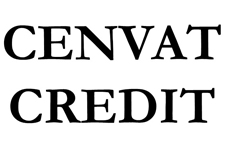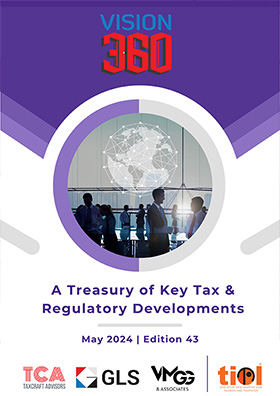CENVAT - Rule 6 of CCR, 2004 - Amount of 5%/10% paid to Government but also 'recovered' from customers - such amounts cannot be treated as 'additional consideration' and added to sale price so as to again demand 5%/10% on same: CESTAT by Majority
By TIOL News Service
NEW DELHI, 24 JUNE 2015: THE appellant availed CENVAT credit and manufactured both dutiable and exempted final products but did not maintain separate accounts/inventory of inputs. Therefore, in terms of the provisions of Rule 6(3) of the CCR, 2004 they were paying an amount equal to 5%/10% of the sale value of the exempted final products at the time of their clearances. However, in the invoices, the amounts of 5%/10% of the sale price were being mentioned as "CENVAT Credit reversal", and were being recovered from their customers.
The Department was of the view that the amount being recovered from the customers has to be treated as 'additional consideration' for the goods sold and as such, the same would be part of the saleprice. And that the manufacturer should pay 5%/10% on these amounts of 5%/10% collected!
Three SCNs found their way for the period April 2005 to August 2011 and the demands totalled up to more than Rs.2.5crores.
The CCE, Bhopal did not waste much time and by a common order dated 30.07.2012 confirmed all the three demands along with the additional baggage of penalty and interest.
Before the CESTAT, the appellant submitted that the matter is covered in their favour by the Larger Bench decision in Unison Metals Ltd. - 2006-TIOL-1337-CESTAT-DEL-LB. The plea of time bar was also raised.
The AR submitted that the judgment of the Tribunal in the case of Unison Metals Ltd. cited by the appellant and the Board's Circular No.870/8/2008 dtd. 16.05.2008 based on the same, is not applicable to the point of dispute in this case.
The Member (Technical), while concluding that the amount recovered has to be treated as additional consideration and, hence, part of the sale price and as such on this amount also the amount @ 5% / 10% under Rule 6(3) would be required to be paid, accepted the argument on time-bar and remanded the matter for re-quantification.
The Member (Judicial) while referring to the cited LB decision & the Board Circular observed that the only difference in the Unison case was that in the said case demand was made u/s 11D of CEA, 1944; that it stood clarified that as long as the amount 8% or 10% is paid to the Government in terms of Rule 57CC/Rule 6, the provisions of s. 11D shall not apply even if the amount is recovered from the buyers and, therefore, the demand of duty on the same amount by treating it as part of the assessable value is not in accordance with the said rule.
The Member (J) also adverted to the decisions in Kisan Sahkari Chinni Mills Ltd. - 2002-TIOL-394-SC-CX and Sujana Metal Products - 2009-TIOL-1096-CESTAT-BANG.
Nonetheless, the Member (J) agreed with Member (T) on the point of limitation and penalty and concluded that the order passed by the CCE, Bhopal is required to be set aside in its totality and the appeal is required to be allowed.
Therefore, the following difference of opinion was referred to the Third Member -
'Whether the appeal has to be allowed on the point of limitation and penalty and the matter is required to be remanded to the Commissioner for re-quantification as held by my learned brother Member (T) or the impugned order is required to be set aside in its totality and the appeal is required to be fully allowed as held by learned Member (J).'
We reported this case in October 2013 as 2013-TIOL-1513-CESTAT-DEL.
The third Member on reference has passed an order recently.
The Member (Judicial) held that the appellant is paying 5% / 10% of the value of the goods to the Revenue as per Rule 6(3) and not claiming any deduction of 5% / 10% on the said amount and, therefore, they are not required to pay 5% / 10% on the amount recovered from the buyer. While coming to this conclusion the Member (J) took support of the decisions in the case of Unison Metals - 2006-TIOL-1337-CESTAT-DEL-LB and Kisan Sahkari Chini Mills Ltd.- 2002-TIOL-394-SC-CX and distinguished the cases cited by the AR of Mukand Ltd. - 2009-TIOL-1685-CESTAT-MUM and Mahindra & Mahindra Ltd. - 2007-TIOL-534-CESTAT-MUM.
Nonetheless, the third Member on reference felt it apt to explain the fallacy in the argument advanced by the Revenue.
This is what the Member (J) explained as being "simple logic" -
++ The term "value" has not been defined under the Act. In Central Excise Act, the term value is known as "Assessable value" i.e. value of goods on which duty is payable. In this case, the contention of the Revenue is that the appellant is required to pay 5% / 10% of the sale price of the exempted goods. Therefore, it is necessary to understand which is sale price.
++ The term "Sale Price" means the price at which the goods is sold to the Customer which is different from the assessable value of the goods.
++ To understand the same I have to explain the same by way of an example.
++ Suppose, if the value of input is Rs.50/-, cost of manufacturing of the product is Rs.50/- and the rate of duty is 10%. If appellant is manufacturing only dutiable goods then the input value is Rs.50/- (Credit availed on input) plus the cost of production is also Rs.50/- therefore, the value of the goods is Rs.100/- on which duty is payable at 10%, the sale price of the goods is Rs.110/-.
++ If the appellant is manufacturing exempted final product then also value of input is Rs.50/- (Cenvat Credit availed on input) plus cost of production is Rs.50/-. The value of goods is Rs.100/-. Appellant is paying 5% / 10% of this Rs.100/- to the Department for availment of Cenvat Credit on inputs as per Rule 6 (3). The appellant has recovered 10% from the buyers as per Rule 6(3) ibid, therefore, the Revenue is seeking the appellant is to pay 10% of Rs.110/- i.e. on the sale price. From the above example, I find that in case of dutiable goods the appellant is charging 100+ duty as applicable rates and in the case of exempted goods the appellant is paying Rs.100/- + 5% / 10% of Rs.100/- as per Rule 6(3). The value of the goods in both the case is Rs.100/-. Therefore, question of payment of 5% / 10% of the amount recovered from the buyer on account of payment made to the Department as per rule 6(3) does not arise by a simple logic as stated above. As per Rule 6(3) ibid, the appellant is required to pay 5% / 10% of the value of exempted goods not of the sale price.
In fine, the third Member on reference agreed with the view taken by the Member (Judicial).
So, in view of the majority order, the appeal was allowed.
In passing: By the way, the reference was…. Be that as it may, this is what was mentioned ten years ago in DDT 124/30.05.2005 and later reproduced in DDT 869/21.05.2008 after issuance of the Board Circular 870/8/2008-CX, dated 16.5.2008. An extract therefrom-
"So 11D is out. Then should this ten percent collected from the customer be added to the price to arrive at the ten percent? This will lead to absurd situations. Suppose the price is Rs 100 and the manufacturer collects ten percent from the customer. Now Audit would want this ten percent to be added to Rs. 100 and the amount to be paid should be Rs. 11 (10% of 110). But then if the assessee passes on this additional one Rupee also? Then the price has to be taken as 111 and 10% has to be calculated. This will go on and on till --- till infinity! No! we must stop it somewhere. Why not at the beginning? The point is, he collected Rs 110 and 10% has to be paid on that. But 110 includes 10%. It is 100 + 10. Elementary arithmetic? Not to Audit and some Commissioners!"
(See 2015-TIOL-1226-CESTAT-DEL)














